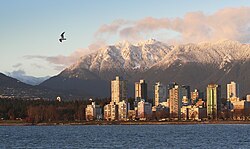West End (Vancouver)
| The West End | |
|---|---|
| Neighbourhood of Vancouver | |
| West End | |

View of the West End and English Bay at sunset
|
|
 Location of the West End shown in red. |
|
| Country | Canada |
| Province | British Columbia |
| City | Vancouver |
| Area | |
| • Total | 2.04 km2 (0.788 sq mi) |
| Population | |
| • Total | 44,560 |
| • Density | 21,833/km2 (56,548/sq mi) |
| Website | West End Community Webpage |
The West End is a neighbourhood in Vancouver, British Columbia, Canada on the Downtown Vancouver peninsula neighbouring Stanley Park and the areas of Yaletown, Coal Harbour and the financial and central business districts.
The definition of the "official neighbourhood" of the West End, according to the city, is the area west of Burrard Street, east of Denman Street, and south of West Georgia Street. Historically the term originated and remains used by Vancouverites to refer to everything from Burrard Street to Stanley Park, including the Stanley Park Neighbourhood west of Denman Street and the Coal Harbour Neighbourhood. Coal Harbour Neighbourhood is officially designated as west of Burrard and to the north of West Georgia, although the newly built areas between West Pender Street and the waterfront are expressly "Coal Harbour" and not considered part of the West End.
Like all of Vancouver, the West End was originally a forested wilderness. The area was purchased in 1862 by John Morton, Samuel Brighouse, and William Hailstone, three men known as the "Three Greenhorn Englishmen," or just the "Three Greenhorns," owing to the belief that the naive men paid too much for the remote land. The men had plans to establish a brickworks on the shore of Coal Harbour, and their land claim was originally staked with the hopeful intent of mining for porcelain clays, but the grade of clay was not fine enough for that use. When those plans failed (a lack of transportation being a key factor) they sold a good portion of the area, by then known as the Brickmaker's Claim, to Victoria investors who in turn tried to promote its development as New Liverpool. The only thing that happened with that scheme was a subdivision plan registered with the Land Titles office in New Westminster. Another name used for the property was the Brighouse Estate (Brighouse as a name came to refer to a particular part of Richmond, where "Greenhorn" J. Morton also owned property). One of the partners, observant that brick was a valuable building commodity despite the abundance of timber in the region, moved the brick-clay operations to Sumas Mountain, establishing the community of Clayburn, now a neighbourhood of Abbotsford.
...
Wikipedia
